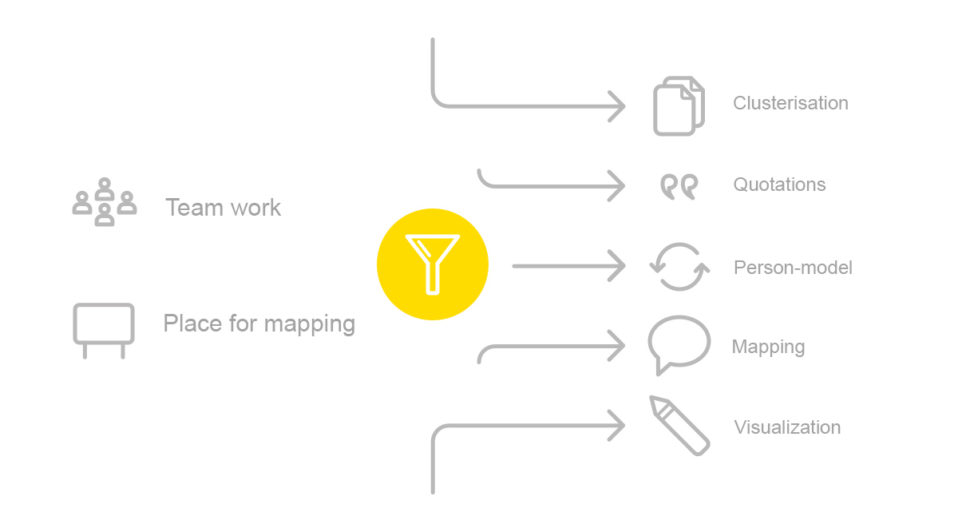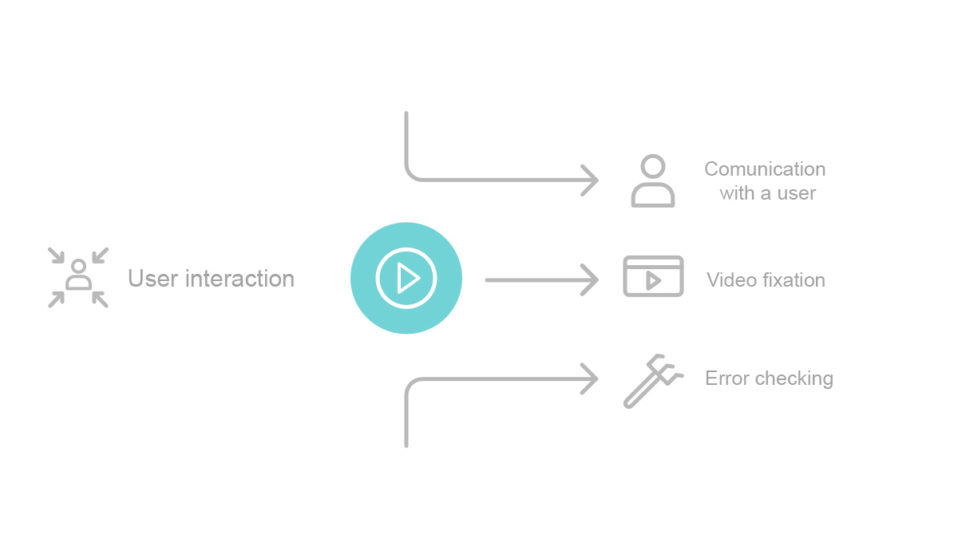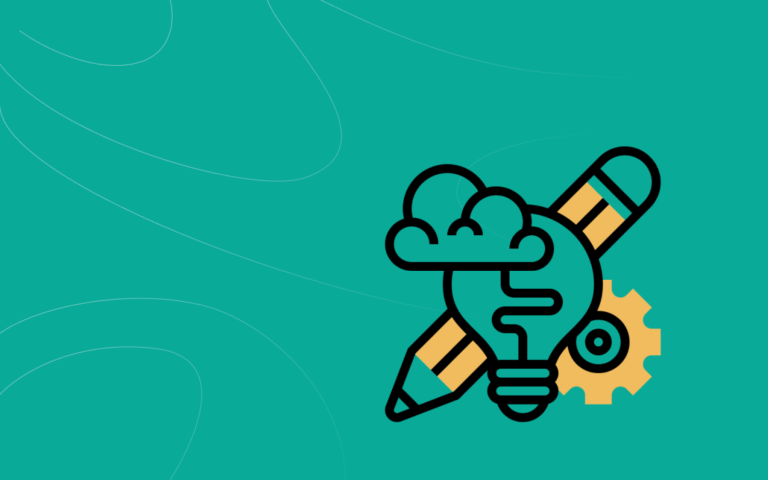To make a product profitable, you need it to meet your customers’ needs and solve your target audience’s issues. We understand that sometimes it is difficult to be objective when trying to implement an idea, which can negatively affect the product. In this case, design thinking will help you look at the development process from all sides and see the picture from different angles.
Design thinking assumes a human-centered approach, and more and more industries are turning to this approach to develop their existing products or services. What is design thinking? This article will define this concept, consider the principles on which design thinking is built, and the stages into which the process and tools are divided to help you at each stage of building design thinking.
What is design thinking?
Design thinking is both an ideology and a process to solve complex problems, which considers the client’s interests. It focuses on achieving results like:
- Technically feasible: they can be converted into functional products or processes;
- Economically viable: business can afford to implement them;
- Desirable for the user: they satisfy a real human need.
Design thinking in the business allows you to present the most fantastic solution to appeal to customers and bring it to life. And if suddenly something goes wrong, go back to the previous stage and redo it. In other words, to propose innovative solutions, you need to embrace the designer’s mind and approach the problem from the user’s point of view.
Design thinking makes people feel timid – as if it requires completely different skills than we ordinary people have. When people talk about designers, high fashion immediately comes to mind. I am not able to combine two pieces of clothing well. We are trying to make sure that the user gets exactly what he/she wants.
Dave Jarrett. Think Like a Designer. Design Thinking for Managers
The design thinking process describes a series of steps that bring this definition to life – from understanding a user’s problem to coming up with ideas and turning them into prototypes. And then you can see that there is something in common with the UX. Let’s take a look at the peculiarities of design thinking.
Design Thinking helps us solve challenging issues
You don’t need design thinking if you want to solve a common problem. There are proven approaches to this. As for complex issues that cannot be solved by standard methods and procedures, it is necessary to apply design thinking. It is essential because an attempt to solve such a problem using standard methods can lead to even more issues. These challenges can be managing change, achieving sustainable growth, or maintaining a competitive edge.
Design thinking helps to maintain user focus, creativity, innovation, and thinking outside the box.
Principles of Design Thinking
As with any methodology, there are principles in this approach that are critical. We’ll look at the methodology itself a little later, but now we’ll talk about five essential design thinking principles.
- Idea. The point is to apply this principle to generate many ideas to find the one we will implement.
- Collaboration. Design thinking involves collaboration between different kinds of teams to bring together many different perspectives and ideas. It is this approach that leads to innovation.
- Experiments. After the idea is formed, it is necessary to recreate the prototype to test the viability concept. With visible flaws, it is worth reworking the concept and prototype until you get the desired result.
- Be aware of the process. Developing a holistic vision requires a conscious and attentive approach – identify the project’s main stages and determine the ultimate goal.
- Call to action. Design thinking is a practical approach to solving problems, which means less discussion/hypothesis about what your users want, more realistic steps – conducting field research, communicating with focus groups. This way, you can test your prototypes in real conditions, which reduces the risk of a future failure.
What drives design thinking?
The rate of change in business and society, caused by technology development speed, is the driving force behind design thinking development. The more companies implement software, and the rate of their transformation increases, the complexity of these changes increases.
Many companies are ready to introduce small innovations, but as far as radical changes are concerned, in most cases, this is an almost impossible task. To drive disruptive innovation, they must find ways to embed and expand the creativity of their organizations.
Long-standing business models are being disrupted by digital transformation, and it also requires a shift in mindset from problem-solving to the search of issues. A tool such as design thinking helps to understand and simplify processes and improve customer service. Design thinking minimizes risk, lowers costs, increases speed and energizes employees, helps to find the basis for solving complex human-centered problems and making the best possible decisions about:
- A new definition of value
- The new invention of business models
- Changing markets and behavior
- Change of organizational culture
- Complex social problems
- Issues affecting different stakeholders and multiple systems
People want their interactions with technology and other complex systems to be simple, intuitive, and enjoyable. When done right, the human-centered design improves the user experience at every touchpoint and helps create products and services that resonate deeply with customers.
John Kolko, “On the Evolution of Design Thinking,” Harvard Business Review
Design thinking starts with understanding the unmet or unspoken needs of customers or users, minimizing uncertainty and innovation risk by engaging customers or users through a series of prototypes to explore, test, and refine concepts. In other words, the results of real-life experiments provide the best insight into customers, as opposed to classic market research or statistical data. A combination of the traditional approach and design thinking will give the best result.
Design Thinking Methodology
Many words have already been saying about what design thinking is and what principles it is based on. Let’s take a look at what a design thinking methodology looks like in action, which can be divided into three distinct phases: immersion, idea generation, and implementation. This structure is further broken down into usually five actionable steps that make up the design thinking process:
- Empathize
- Define
- Idea
- Prototype
- Testing
Of course, all of these steps can be performed sequentially, but you can also change the order because design thinking does not follow a strictly linear process. And as we mentioned earlier, design thinking is an iterative process where you may need to repeat steps and even return to previous actions.
#1 Empathize

Design thinking starts with empathy. In other words, it is vital to understand who your users are and what their needs are. It is the only way you can create the products and services you want. It is also essential to find an answer to questions such as:
- What are the expectations of customers from your product?
- What issues do they want to solve with your product?
At the Empathize stage, interaction with the target audience usually occurs, interviews take place, and special attention is paid to people’s reaction to the product (their facial expressions, gestures). This way, you get real feedback and cross out some of your assumptions, and first-hand information will help you design with real users in mind.
It is impossible to create a successful product without understanding who it was made for.
#2 Determine
This is the second stage of the design thinking process, where you define the user problem you want to solve based on the conclusions you made after the first step.

At this stage, you will formulate the so-called problem statement or, in other words, Proof of View. A POV is a statement that focuses on the observation findings and the needs of a particular user or persona composed of characteristics of different users.
Formulating the problem in design thinking is essential to retain the user’s attention. For example, instead of presenting the issue as a business goal, “We need to increase gym attendance among people over 50 by 30%,” you shape it with a people-centric point of view: “People over 50 in London need flexible, affordable access to sports. convenience for keeping fit and healthy”.
The only way to find the right solution is to understand the problem correctly.
Alexandra, Chief Transformation Officer
As with any design thinking process, the problem statement grabs the user’s attention. Instead of phrasing the problem as a business goal – “We need to increase gym attendance among people over 50 by 30%,” – you can articulate it from the point of view of the user: “People over 50 in New York need a convenient a sport to keep fit and healthy”.
As a result, you will have a formulated problem that you will seek to solve in creating a project.
#3 Idea
The idea generation phase is a key transitional phase, from studying your users and problems to finding solutions. When done correctly, an idea session is where innovation thrives; this should help you stumble upon the kind of groundbreaking solution your users have been missing!
When generating ideas, you do not need to evaluate and discuss them, even allow those ideas that seem unattainable or crazy to you. Take full advantage of lateral thinking.

At this point in the design thinking process, you will continually return to the problem statement. As you prepare to move on to the next stage, you will narrow your list of ideas to just a few, which you later turn into prototypes for testing with real users.
#4 Prototype
At this point in the design thinking process, your ideas are transformed into prototypes. A prototype is a scaled-down version of a product or function, a simple paper model, or a more interactive digital representation. You can read more about prototypes in our article MVP vs. PoC vs. Prototype in App Development.

Prototyping provides a sense of the product, which means users can test it. This way, you maintain a customer-centric approach, allowing you to collect feedback before starting product development. It ensures that the final design solves the user’s problem and is a pleasure to use.
Remember that a high-quality prototype does not require developer involvement during testing!
#5 Test
Prototyping and testing are two steps that must be considered together.

Testing is a relatively simple stage, where you present the created prototypes to real users, and you can see how they interact with them. You will be able to see user reactions and get feedback from them. Also, at this stage, you will have the opportunity to identify product flaws and eliminate them.
When testing a prototype, it’s important to ask users what they don’t like. For example, in web development, user feedback can be like this. It’s good when there are no “Can I help you” pop-ups, but there is a hidden feedback form in the form of a question mark through which users can send a question or suggestion to the support service.
The task of testing is to understand whether the product is catchy? If so, you can start developing the MVP, release the first version, and conduct more complex testing. If nothing hooked the user, then it’s worth returning to the stage of generating ideas. Testing saves resources since you have not yet had time to invest a lot of money in development and implementation at this stage.
The design thinking process is not linear. And the results of each stage may require you to go back to the beginning or one of the intermediate steps before creating that very prototype.
How to apply the concept of design thinking in your work?
It’s worth saying right away that you don’t need to be a UX designer! You can concentrate on one direction, whether meeting and learning your client through empathy or generating ideas. In case you find it challenging to collect customer feedback, you can interview users and find out their needs.
If you need to find a solution to a complex problem, you can arrange brainstorms, mind mapping, bodystorming, reverse thinking, etc., with different team representatives. It is beneficial to have brainstorming sessions if you notice some misunderstanding between specialists from various departments.
Design Thinking is a method that involves learning through experimentation. Everyone makes mistakes, and the most important thing here is to conclude. Often, the most obvious or most radical idea becomes an excellent basis for design decisions.
It might seem like the design thinking process is very structured, but it’s quite flexible. Depending on the goals, experience, and type of product, you can combine the components, return to the steps already passed or, if necessary, start from scratch. Design Thinking is a creative method that can be enhanced and reinforced with some tools:
- mental maps
- visualization
- storytelling
- mood boards
To use design thinking, you need colored sticky notes, markers, and a chat room. Ask your team a question, inspire – and jot down a string of answers!
The main merit of design thinking is not so much in its innovativeness as in its applied nature. Combined in a simple and understandable chain, work methods are now suitable for solving marketing problems but generally applicable within any process.
FAQ
- To generate ideas and solve problems.
- To communicate. One picture is worth a thousand words. One prototype is a thousand pictures.
- To start a dialogue. User interaction is more useful when it is built around something like a prototype.
- To test the possibilities. You have the opportunity to try several ideas at once without choosing any one direction.
- To manage the solution development process. Identifying mutable conditions makes it possible to divide a large problem into several small ones.
Design Thinking Tools to Try with Your Team
Design Thinking is not just an activity where everyone gathers in a room and seriously thinks about design decisions. It is an iterative process with five steps: empathy, definition, idea generation, prototyping, and testing. And at every step, essential tools and applications emerge to help you succeed. Keeping milestones in mind, we’ve rounded up some of the best design thinking tools to help create real value for users.
Keep in mind that testing is not the end of the design thinking process, and you are likely to find information about your users that will determine the nature of the problems they are facing.
Summary
Design Thinking is suitable for use in any company with customers or users, as it helps to truly understand its users and create solutions based on the needs and problems of these people.
The design thinking process is excellent for solving complex problems and delivering solutions that target how your users will or already interact with your product. After all, any organization’s success largely depends on the people who use the products or services it provides. By designing solutions for these people, your team can create targeted solutions that can significantly impact user activation, retention, and growth.






